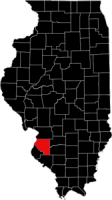St. Clair County

Location of St. Clair County in Illinois.

Location of St. Clair County in Illinois.
In the 1720s, Le Page du Pratz visited a Natchez village near New Orleans and observed men playing games with a disc-shaped stone. In one game, a man rolled a stone across the ground. When the stone came to rest, other men wagered on who could cast a spear closest to the stone. Du Pratz published his account of the game and other aspects of Natchez life in a book titled The History of Louisiana.
Archaeologists have found disc-shaped stones among the remains of ancient Native American villages in Illinois. Based on close inspection of the objects, it appears that artisans shaped granitic rock with a stone hammer, slowly removing small bits of stone until they created the desired size and shape. The diameter of discoidals varied, ranging from about three inches to five or more inches.
Discoidals first appeared in Illinois about 1,400 years ago, more than a thousand years before du Pratz observed their use. Additional evidence of a prehistoric chunkey game includes a 900-year-old fire clay statuette found in Oklahoma that depicts a kneeling man holding a disc-shaped stone as if preparing to roll it forward. Based on du Pratz’s account, some archaeologists speculate that large open plazas at 900-year-old Mississippian communities such as Cahokia may have been used for games that attracted large crowds.
Similar games persisted into at least the early 19th century. A George Catlin painting portrays game playing among the Mandan tribe on the Great Plains.